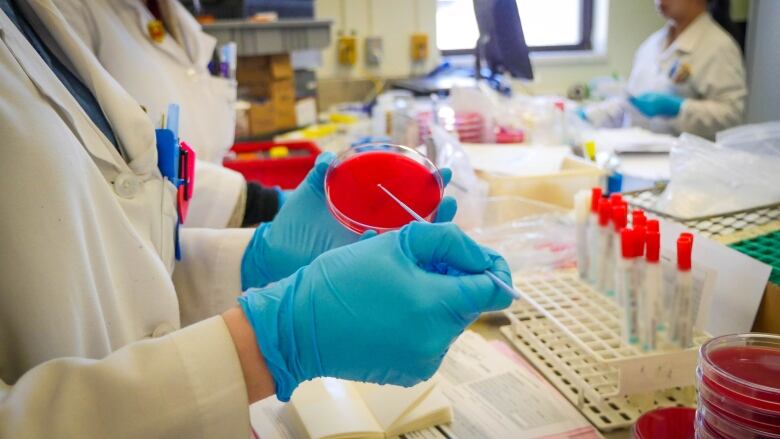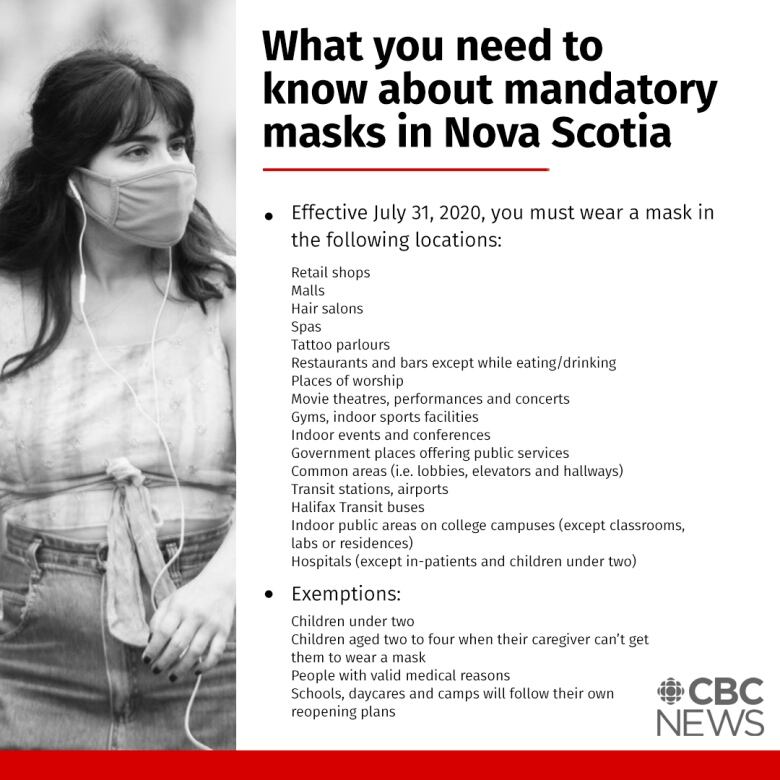2 new COVID-19 cases in Nova Scotia; province clarifies mask rules
Premier says province still looking for safest way to reopen to rest of Canada

Nova Scotia announced two new cases of COVID-19 on Friday.
Both cases are in the Central Zone, according to a news release.
The two cases are Nova Scotians who travelled outside of Canada but have been in self-isolation since returning to the province. This comes after more than two weeks of no cases in the province.
Premier Stephen McNeil said during a news conference Friday that Nova Scotia is still looking for the safest way to reopen to the rest of Canada, but the province "is not there yet." He did not offer anytimeline.
"We can not continue to keep ourselves locked down," he said. "There are many parts of the country that are doing as well as we are.
"There's certainly a level of anxiety in our provinces about doing that. But we need to make sure that as we protect the public health of our citizens, we need to now begin to look at the economic health."
Dr. Robert Strang, Nova Scotia's chief medical officer of health, said on Friday that the province hopes to move toward an approach based on risk to determine who gets followup calls or messages to make sure people are self-isolating for 14 days.
Masks mandatory starting Friday
Friday is the first day formandatory use of non-medical masksin most indoor public spaces in the province.
However,Health Minister Randy Deloreysaid on Thursday the province is taking an honour-system approach to the mandatory mask policy.
Strangsaid Friday he's getting questions about why the mask policy is being implemented now.
He said Public Health's position has changed because of new evidence around the virus and the use of masks.
"Adapting our approach should be seen as a positive rather than that we were wrong at some point in the past," Strang said.
"The reason that it's important to make masks mandatory now, even with few active cases, is part of being prepared for the likely occurrence of a second wave."

Strang reiterated Friday that there is a $1,000 fine on the booksfor anyone not following the public health rules. But there are no plans to be heavy-handed.
"I believe in the goodness of people," he said.
Strang also said people are not required to provide proof that they have a medical condition that prevents them from wearing a mask in public places.
"We're asking employers and businesses to take people at their word," he said. "There might be some people who take advantage of that, but I believe that most Nova Scotians are prepared to do the right thing and wear a mask."
Plexiglas, face shields do not replace need for masks
Strang clarified several points around wearing masks in indoor public spaces on Friday.
He said those spaces are defined as wherever the public has ready access. He said in an office building the lobbies, hallways and elevators would be considered publicwhile the offices would be private.
Strang said that while Plexiglasadds an additional layer of protection, it does not replace the need for masks. The same is true of face shields, and Strang said a mask must be worn underneath a shield.
A private business meeting with fewer than 50 people would be considered a private space with no masks required, Strang said. However, a person hosting a wedding reception is in the gathering category, so masks would need to be worn.
"When in doubt, wear a mask. If you're not sure, always err on the side of caution," he said.
Strang said it is safe to wear masks for long periods of time. But if it gets wet or soiled, it should be changed.
He also said that provincial libraries, museums, homeless shelters, access shelters and schools will all have reusable non-medical masks for anyone who needs them. He said small businesses can apply to get a supply from the province as well.
The province has also added a section about masks to its website, which details when to wear a mask, making masks and how to get help accessing masks.

Students coming in the fall
Strang said he has been consulting with the university presidents about students returning to the province in the fall.
He said students will be required undercodes of conduct to quarantine for 14 days when coming from outside of Atlantic Canada, even if the Atlantic bubble disappears.
Strang said Public Health is working closely with universities on how best to monitor the students coming in and how the province can support the schools in doing that.
Potential exposure on Air Canada flight
Public Health is advising of a potential exposure to COVID-19 on Air Canada Flight 626 on July 19 from Toronto to Halifax. The flightleft Toronto around 10 p.m. and landed in Halifax at 1 a.m. on July 20.
Anyone on the flight may have been exposed, but passengers in rows23, 24, 25, 26, 27,seats C, D-Fare more likely to have had close contact.
Passengers in those seats are asked to call 811 for advice.
Those on the flight who were exposed to the virus may develop symptoms up to 14 days after, which is up to and including Aug. 3.
Symptoms list
The QEII Health Sciences Centre's microbiology lab completed 456 tests on Thursday.
The province has recorded 1,069 cases and 64 deaths related to the virus. There is no one in hospital related to COVID-19 and there have been63,647 negative test results.
People with one or more of the following COVID-19 symptoms are asked to visit811's website:
- Fever (chills, sweats).
- Cough or worsening of a previous cough.
- Sore throat.
- Headache.
- Shortness of breath.
- Muscle aches.
- Sneezing.
- Nasal congestion/runny nose.
- Hoarse voice.
- Diarrhea.
- Unusual fatigue.
- Loss of sense of smell or taste.
- Red, purple or bluish lesions on the feet, toes or fingers that do not have a clear cause.












_(720p).jpg)


 OFFICIAL HD MUSIC VIDEO.jpg)
.jpg)



























































































